10 Little-Known Pinoy Christmas Traditions That May Disappear Soon
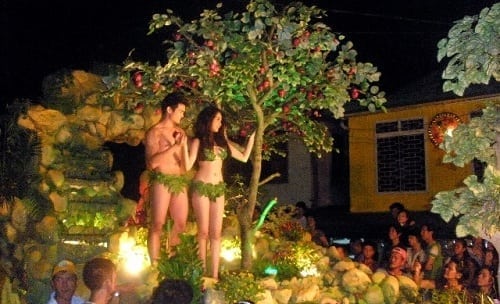
Christmas is the most joyous time of the year for Filipinos, that is why so many customs and quaint practices have been conceived around the holiday season.
Traditions like Noche Buena, Misa de Gallo and giving of aguinaldos continue to live on, but there are other local and obscure traditions that old towns observe that we know so little of—some vanishing, others forgotten, but all very Filipino!
Also Read: 9 Fascinating Facts You Didn’t Know About Christmas in the Philippines
1. Pastorella
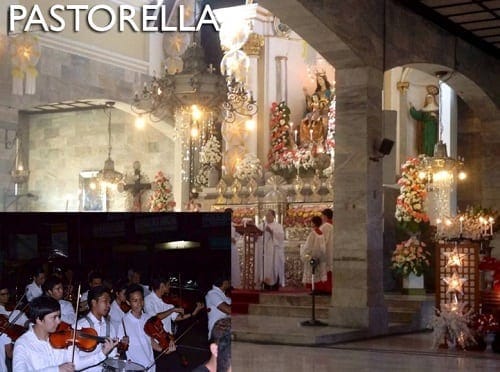
During the nine-day midnight masses, the parish choir of Mabalacat in Pampanga performs Latin hymns like Kyrie (Lord, Have Mercy), Gloria (Glory to God in the Highest), Credo (Apostle’s Creed), Agnus Dei (Lamb of God) and other parts of the Mass like no other choir does—with operatic flourish and high drama complete with violins.
The songs are collectively called ‘pastorella’ (from Misa de Pastores, Mass of the Shepherds) brought from Spain during colonial times but adopted by local musicians who made them more spectacular and melodramatic. The Spanish friars collaborated with our ancestors to come up with all sorts of gimmicks to make church services worthy alternatives to their folk practices, one of which was the pastorella.
Related Article: 7 Surprising Facts You Didn’t Know About Christmas
The Misa de Pastores is still in practice in Spain, Portugal, and Mexico, where it is sometimes called Misa de los Pastores and Misa de Gallo (Rooster’s Mass). In the Philippines, however, there are just a handful of parishes where they still sing the pastorella —with the Mabalacat parish in Pampanga leading the way.
2. Dia de los Tres Reyes (“Tatlong Hari”)
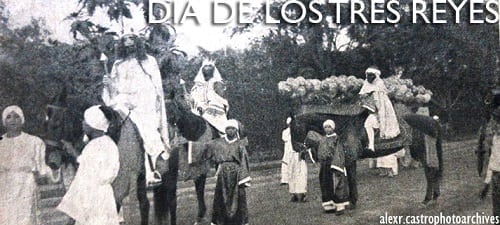
Time was when the Feast of the Epiphany or Three Kings was a fixed date—January 6—which also marked the end of the Christmas season. With the 1969 revision of the General Roman Calendar, the date has become variable, celebrated on the first Sunday of January.
In the Philippines, the Three Kings were looked at as gift-givers, the way Americans looked at Santa Claus. This began in the Spanish times when the “Dia de los Tres Reyes Magos” was celebrated in Filipino homes with feasting, merry-making, and gift-giving. Children would leave their buffed shoes all in arrow outside their rooms to find them stuffed with gifts the next morning—courtesy of the Three Kings!
READ: 8 Vintage Photos of Filipinos Having a Merry Christmas
The Spanish community kept the custom alive, even after the Americans introduced their own Christmas, through the efforts of Casino Español de Manila, a socio-civic-recreational club founded in 1844 for Spaniards living in Manila. On January 6, Spaniards dressed like Melchor, Gazpar, and Balthazar, take to the streets lined with Spanish children to distribute gifts. Instead of camels, the Kings ride horses, wending their way as children cheer.
To this day, Casino Español has continued to celebrate the Three Kings’ gift-giving tradition without the pompous street parade, limiting the activities at the Casino de Español grounds. The Feast of Three Kings is also known as “Araw ng Matatanda” in the Philippines.
3. Pahalik
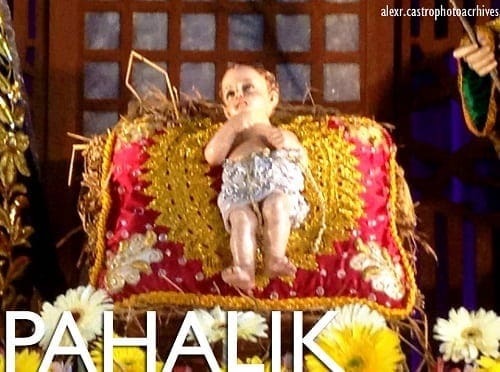
The Christmas Midnight Mass in the Philippines is full of theatrical highlights—from the appearance of the guiding Star that magically ascends and positions itself on top of the Belen as the “Gloria” is sung, while the scene on the stable is dramatically lit to reveal the newborn Christ Child.
Also Read: 7 Most Unintentionally Terrifying Statues In The Philippines
At the end of the Mass, the faithful line up along the communion rail to kiss the feet of the Niño as a gesture of welcome and respect—known as Pahalik.
In Laguna, there exist stories of the unauthenticated kind, about the peculiar practice from Yuletide pasts, in which the image of the Child is passed around and kissed by young ladies on the lips, rather on the feet. Legend has it that this “beso” was an attempt to make the baby wink.
4. Panunuluyan
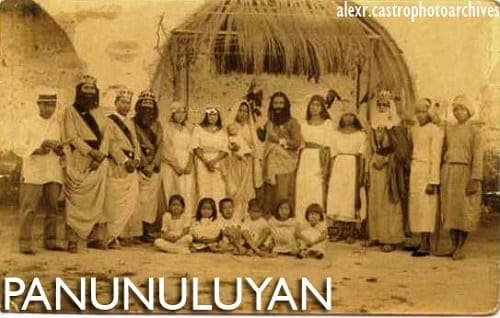
The Christmas Panunuluyan is a holiday theatrical tradition, which dramatizes the search for lodging of the Holy Couple, Jose and the pregnant Maria.
Originally, the images of the two, atop decorated carroza (carriage), were processioned on Christmas Eve and taken from house to house, in a re-enactment of the Bethlehem event. The images were preceded by altar boys bearing ciriales (cross and candles on poles) and devotees.
Eventually, real people, instead of santos, were cast to assume the roles of Jose and Maria. The chosen ones are almost always respectable citizens of the town. The dramatis personae expanded to include the 3 Magis, a Narrator, and a Koro—singers who sang and delivered verses for the Holy Couple.
Recommended Article: 9 Astonishing Miracles in Philippine History
Several houses are selected as “inns,” to be visited by the Holy Couple, who either walk on foot or ride the back of a carabao or a horse. At the first house, San Jose begs the “innkeeper” for a room, chanting his lines in verses. The “innkeeper” sings his response, claiming his house is full, thus turning the couple away.
The couple moves on to the next house, and then to the next, meeting the same cold response. Finally, the procession winds back to the church plaza, where a stable has been constructed. It is here that Maria delivers Jesus, amidst the ringing of bells and the celebration of a Misa de Aguinaldo, the last of the Simbang Gabi.
5. Tinubong, Ilocandia’s Christmas Cake
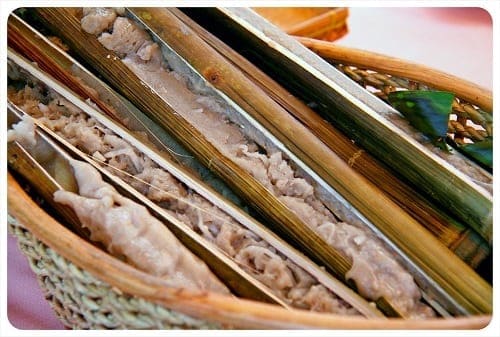
Victor Villanueva via Flickr
Christmas is not Christmas in the Ilocano home without a delicacy called “tinubong.” This Christmas cake has an unusual appearance, cylindrical shape, two feet long and two inches in diameter.
Curiously enough, it is cooked not in pots and pans but in sections of a green bamboo, locally known as “tubong.” It is made from a soft, fragrant rice called “diket,” mixed with sugar and coconut milk. Peanuts and anise are optional flavorings to give “tinubong” a taste twist.
Also Read: Top 10 Most Bizarre Filipino Foods
The mixture is poured into bamboo tubes which are sealed and inserted in burning heaps of rice husks. When white sugar is used, the cake comes out white and is called “Castila.” Brown sugar results in a dark cake called “Negro.” The “Castila” version is served to town officials, important people and visiting guests.
“Tinubong” is commonly made in northern Ilocos Sur in the towns of Lapog, Cabugao, Sinait, and Magsingal. Americans may have their raisin pudding and fruitcake for Christmas, but the Ilocanos take pride in a sumptuous treat expressly made for the holidays—the tasty, yummy, home-cooked“tinubong”!
6. The Fish Lanterns of Pampanga
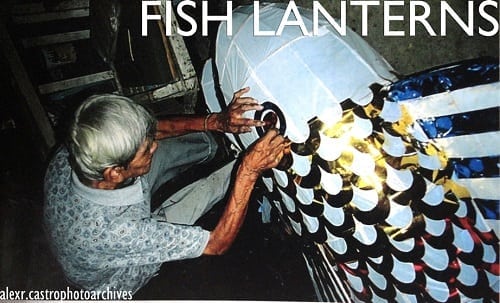
Everyone is familiar with the star-shaped lantern that symbolizes the bright star that guided the Magis and shepherds to the stable where Jesus was born. But there exist other lantern shapes that are processioned in Angeles, Pampanga during Christmas time.
Local historian Mariano Angeles recorded such event in 1830 when a procession featured “quaint, illuminated lanterns made of the same material (bamboo and paper), depicting aquatic animals, in skillful and artistic imitation of the real ones. The big paper fishes and lobsters, by means of ingenious contrivances, are made to move their dorsal and caudal fins, their mouths, and their eyes.”
The Fish is, of course, a symbol of Christ, and the lanterns serve as added attractions to the religious processions. Only a few barangays in Angeles still have the fish lantern in prusisyons, as the last maker of such lanterns, Eulogio Catahan (Apung Eloy) passed away in late 2012.
7. Baca-Baca
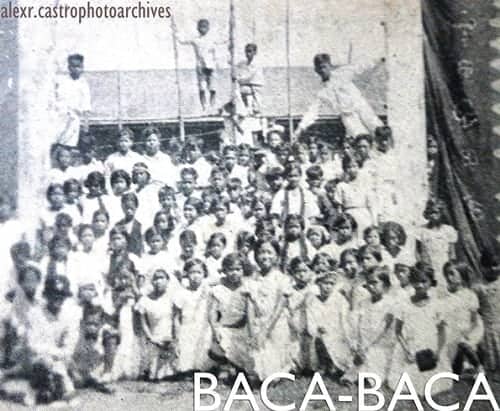
Paracale, the gold town of Bicol, has a novel Christmas custom practiced by children in the 20s and 30s.
The use of band music to liven up Filipino Christmases has long been part of our tradition, but brass band music is never heard in Paracale. Instead, music is generated by children using bamboo flutes and trumpets, hornpipes and shell gongs—in place of expensive musical instruments.
This age-old custom, which dates back to the first discovery of gold in Paracale, is called “baca-baca.” It was aimed at coaxing the populace to get out of their beds and go on a celebratory mood.
READ: 7 Traditional Filipino Games You’ve Probably Never Heard Of
Noisemakers are organized into a team in several streets, with the biggest group composed of 60-plus members. When the church bells sound the first call, the groups of children—following different routes, walk en masse and enter the church on time for the Mass.
Three times during the Mass, the children blow their pipes and horns in unison. Once their mission is accomplished, the children are treated to traditional puto, suman and bibingka.
8. Majigangga Festival
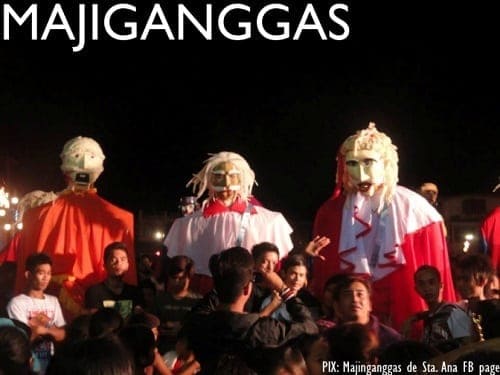
The more well-known Higantes Festival in Angono has a counterpart in Sta. Ana town of Pampanga known as Majigangga. Giant human puppets representing the dark, evil-looking people take to the streets and revel with the residents in the church patio, from Dec. 16 to Christmas Day, when they are supposedly banished by Christ’s birth.
Also Read: 14 Bizarre And Fascinating Philippine Festivals
The unique tradition was derived from Mexico, where there is a form of street pageant called “mojigangga,” which, in turn, was adapted from medieval Spain. Kapampangan adapted the transported practice, using the puppets as symbols of evil, unlike in Mexico where they represented saints and royal figures.
9. Maytinis
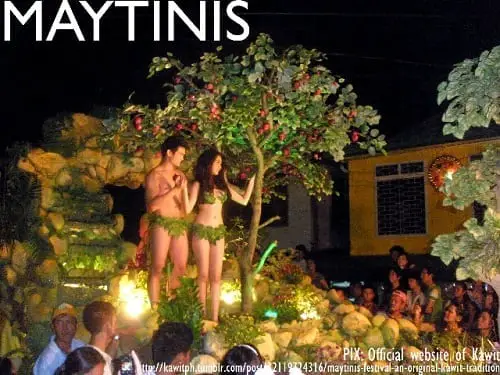
There are several versions of the Maytinis festival around the country, most notably in Cavite and in Pampanga. The term “maytinis” may have been derived from “matins” or evening prayers.
Kawit holds its Maytinis every Christmas eve, which involves the re-enactment of the Virgin Mary and Joseph’s search in Bethlehem, like the “Panunuluyan” (see # 4).
Opulent floats, depicting biblical scenes (Adam and Eve, Moses, Mary, and Joseph) are paraded on the street and culminates with the arrival of the blessed couple at the Sta. Maria Magdalena Church. Mary and Joseph are attended and welcomed by singing angels as they take their place in a giant belen or Nativity scene.
Maytinis in Pampanga is also held on Christmas Eve with the spectacular procession of holy images—patrons of every barangay, accompanied by colorfully lit lanterns of the most amazing variety.
Village choirs singing “Dios te Salve” accompany the faithful as they wend their way through the main streets of the town and back to the church. This tradition is still observed in a few towns and cities like San Fernando, Magalang, Mabalacat, and Mexico.
10. Kanyong Kawayan
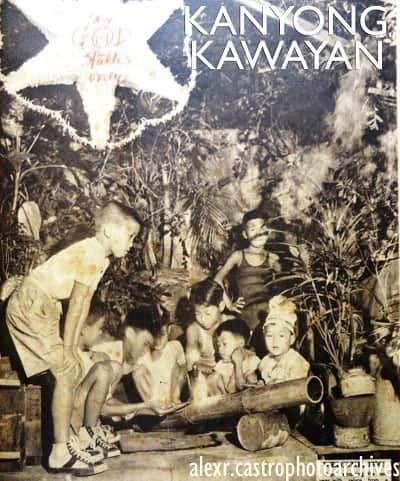
Years ago, in rural communities around the country, the bamboo cannon was a New Year’s Day must-have.
Days before the New Year, fathers would take to the nearest bamboo grove to cut bamboo poles. The poles are trimmed down to about 5 feet in length, sun-dried and the skin scraped off. The bamboo nodes are opened up to let air pass through. A hole is then carved out near the base.
To make the bamboo cannon explode, it is propped up against a stone. Kalburo or wet calcium carbide is fed into the bamboo, until the kalburo reaches the base. Ordinary kerosene is sometimes used. A stick is then lit from a kerosene lamp and then applied on the hole, creating a booming sound. Periodically, one has to blow into the hole to free it from ashes.
Today, the kanyong kawayan is a vanishing noisemaker, replaced by hand-held PVC cannons called “boga.” There have been attempts to bring back the bamboo cannon tradition through the “Kanyong Kawayan Festival” held yearly in Kidapawan and supported by the Department of Tourism.
BONUS Trivia: Aguman Sanduk
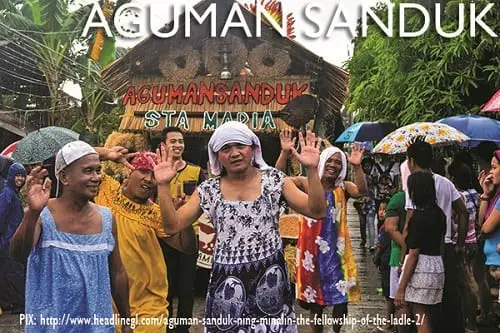
Technically, the Aguman Sanduk (Fellowship of the Ladle) is not part of the Christmas festivities. But its celebration takes place within the holiday period– on January 1 afternoon, while the country takes a rest after welcoming the New Year.
Since its conception in 1934, the menfolk of Minalin, Pampanga have participated in the most flamboyantly freakish parade ever seen. On this day, they dab rouge and lipstick on their faces, put on their wives’ or sisters’ dresses and join others dressed similarly in a riotous street parade.
The tradition started as a dare among men 80 years ago while on a drinking binge—to prove their machismo and as a liberation from repression. The only difference is that the participants are all straight males and boys.
The culmination of Pampanga’s zaniest festival is the selection and coronation of the ugliest cross-dresser, the Reyna ning Aguman Sanduk, where, she is given a ladle as a scepter.
About the Author: Alex R. Castro is a retired advertising executive and is now a consultant and museum curator of the Center for Kapampangan Studies of Holy Angel University, Angeles City. He is the author of 2 local history books: “Scenes from a Bordertown & Other Views” and “Aro, Katimyas Da! A Memory Album of Titled Kapampangan Beauties 1908-2012”, a National Book Award finalist. He is a 2014 Most Outstanding Kapampangan Awardee in the field of Arts. For comments on this article, contact him at [email protected]
Selected References
Afuang, B. (1964). A Town in December. The Sunday Times Magazine, 32.
Castro, A. (2006). Views from the Pampang & Other Scenes. Privately Printed.
Henson, M. (1948). A Brief History of the Town of Angeles.
Orejas, T. (2007). Latin hymns sung in Masses in Pampanga. Philippine Daily Inquirer, p. A1. Retrieved from https://goo.gl/ytjCMu
Pampanga’s Folk Arts. Singsing Magazine.
The Philippine Free Press,. (1936). Celebration of 3 Kings, pp. 28-29.
Ubungen, P. (1935). An Ilocano Christmas Cake. Graphic Magazine, 16-17.
Velas, N. (1935). A Unique Christmas Custom. Graphic Magazine.
FilipiKnow
FilipiKnow strives to ensure each article published on this website is as accurate and reliable as possible. We invite you, our reader, to take part in our mission to provide free, high-quality information for every Juan. If you think this article needs improvement, or if you have suggestions on how we can better achieve our goals, let us know by sending a message to admin at filipiknow dot net
Copyright Notice
All materials contained on this site are protected by the Republic of the Philippines copyright law and may not be reproduced, distributed, transmitted, displayed, published, or broadcast without the prior written permission of filipiknow.net or in the case of third party materials, the owner of that content. You may not alter or remove any trademark, copyright, or other notice from copies of the content. Be warned that we have already reported and helped terminate several websites and YouTube channels for blatantly stealing our content. If you wish to use filipiknow.net content for commercial purposes, such as for content syndication, etc., please contact us at legal(at)filipiknow(dot)net
